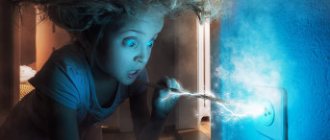Slava Profina 07/25/2018 no comments
-1
The fear of thunderstorms has haunted humanity since ancient times, when people who did not know about such a weather phenomenon regarded it as the wrath of the gods. Over time, the fear of thunder and lightning subsided, especially as their nature became clear. Many people are afraid of thunderstorms; this is just a sense of self-preservation. But this phenomenon terrifies some people so much that people try to hide in the farthest corners. In psychology, fear of thunder and lightning is called brontophobia.
What lies beneath irrational fear?
- Fear passed on from generation to generation The danger of a thunderstorm has always been obvious to man. The desire to be safe and hide from bad weather is a genetically inherent tendency.
- Superstitious and mystical fears Thunder and lightning are still associated with the manifestation of Divine wrath. According to legends, lightning strikes where evil spirits are hidden and can strike a person mired in sins. And cinema helps to consolidate in the subconscious the information that it is during a thunderstorm that the forces of evil reach their apogee, and a flash of lightning will certainly highlight an ugly mystical creature or villain from the darkness.
- Fear of being struck by lightning When struck by lightning, a person receives a powerful electric shock. This can cause cardiac arrest, damage to the central nervous system, burns of varying severity and other injuries. Most accidents result in the death of the victim, but cases of survival are not uncommon. According to statistics, the likelihood of becoming a lightning victim is several times less than the likelihood of being injured in a car accident.
- Fear of ball lightning Ball lightning is a rare and poorly studied phenomenon. Due to the large amount of evidence, science cannot deny the existence of “fireballs,” but scientists have not yet been able to explain the mechanism of formation of ball lightning or recreate it in the laboratory. Witnesses either state that the lightning's movements are chaotic or see rationality in its behavior. What is certain is that the mysterious balls carry a powerful charge of energy and are capable of killing. According to some sources, ball lightning enters a room through an open window or through an outlet. For an impressionable person, this fragmentary but frightening information is enough to make the approaching thunderstorm cause concern.
- Feeling vulnerable During the rampage of any element, people feel vulnerable to the power of nature. Neither scientific knowledge nor technological progress can ensure complete safety. Even the sight of a dark sky foreshadowing a thunderstorm makes a huge impression on an emotional person.
- Negative experience If once during bad weather a person had to seriously fear for his life, then, perhaps, in the future this natural phenomenon will always be associated with a strong threat.
Causes of fears
Most of our fears come from childhood . Adults do not pay attention to children who are nearby and tell scary stories about people struck by lightning, about the unexpected appearance of ball lightning in an apartment, etc.
An impressionable child will not forget these stories and can cultivate them in himself.
Adults will develop fears from their own negative experiences with thunderstorms. This is facilitated by information about deaths from the media, films about natural disasters, the behavior of pets warning of bad weather, as well as the myth of God’s punishment.
Behavioral characteristics of a person suffering from brontophobia
You can recognize someone who is terrified of thunderstorms not only by the somatic symptoms characteristic of all types of phobias, but also by their behavior. The person does the following:
- Hearing a thunderstorm, he looks for a place to hide (bathroom, toilet, closet, etc.).
- Follows all rules of behavior during a thunderstorm: closes windows, avoids contact with household appliances and metal objects, turns off mobile phones and avoids any other conductors of electric current.
- In an attempt to hide from the natural phenomenon, he covers his ears and eyes with his hands.
- Constantly studies statistics on deaths from lightning strikes.
- Carefully monitors the weather forecast.
Such manifestations must be taken seriously. Ridicule and criticism should be avoided. Similar behavior indicates growing anxiety and that the person needs the help of a specialist.
Psychotherapeutic methods
With all the variety of methods for treating phobias, you can’t do without psychoanalysis! A psychoanalyst will help you understand the underlying causes of fear of thunderstorms. In addition, he will give instructions aimed at suppressing fears through simple suggestion.
People try to eliminate phobias discovered in childhood by courageously overcoming oneself. This is a rather tough method and not everyone can do it.
All methods of psychoanalysis are aimed at realizing the unconscious . They help the patient understand himself and draw conclusions.
Thunderstorm and child
During a thunderstorm, children are most often afraid of thunder. The child hears a loud sound, but cannot determine where the danger is and how serious it is. Not understanding what is happening can cause great anxiety. It is very important not to perpetuate this fear. How should a parent act?
- With your entire appearance you need to demonstrate calm and a sense of security.
- You should tell your child about this natural phenomenon in simple words.
- There is no need to scold or shame your child for being afraid.
- During a thunderstorm, you can play his favorite game with your baby to replace negative emotions with positive ones.
- If during bad weather a child wants to be with his mother, he needs to be given this opportunity.
Symptoms of the disease
No matter what a person’s phobia is called, it causes chills and trembling, forcing one to look for a secluded place, hide under a blanket or even in a closet. From the outside, this behavior may seem funny or strange. All signs disappear as soon as the storm subsides.
These symptoms are especially acute if a person with brontophobia is in an open area or in someone else’s room.
The instinct of self-defense forces him to seek shelter, but his behavior at this time is not adequate and can cause negative emotions in other people.
Treatment of brontophobia
People who are afraid of thunderstorms are usually well aware of the irrationality of their fear, but many do not see the need to consult a psychologist. A person suffering from a mild form of the disorder waits out a thunderstorm by sitting in a secluded place. Those most in need of help are those who suffer from a severe form of the disorder and live in a region where thunderstorms are a frequent occurrence.
Hypnosis is the most effective method in treating this type of phobia. Relaxing breathing exercises can help reduce anxiety during a thunderstorm. The treatment uses “positive thinking” methods, during which an analogy is drawn between a thunderstorm and some harmless and pleasant phenomenon.
In severe forms of the disease, medications may also be prescribed. Group work and psychotherapeutic sessions are ineffective in treating brontophobia.
What are our fears called?
Fears associated with thunderstorms and lightning often accompany each other and have their own scientific names :
- Brontophobia - fear of thunderstorms with all its manifestations;
- Keraunophobia is associated with the stories of other people, manifested by the fear of being struck by lightning;
- Tonitrophobia - fear of thunder;
- Astrapophobia - the name comes from mythology, where the goddess of war and thunderstorms, Indra, struck enemies with lightning. She held it in her right hand like a weapon. With its help, she revived her fallen warriors in battle.
“Richmann died a wonderful death...” (M. V. Lomonosov)
Georg Wilhelm Richmann (July 11, 1711 – July 26, 1753) was a Russian physicist who proposed the first model of an electroscope with a scale. In the summers of 1752 and 1753, Richmann actively studied atmospheric electricity and conducted experiments during thunderstorms. One of the experiments ended in the death of the physicist.
The tragedy was witnessed by engraver Ivan Sokolov. An eyewitness said that a pale blue fireball separated from the installation with which the scientist was working and hit Richman directly in the forehead. At the same time, a sound similar to a cannon shot was heard. The physicist fell dead, and Sokolov was temporarily stunned.
Ironically, Georg Richmann managed to witness a rare natural phenomenon, but the resonance throughout the world was caused not by unique scientific information about fireballs, but by the news of the death of a physicist while working with an ungrounded installation.
Richman was the first person to die while conducting experiments with electricity. After a tragic accident, electricity research was temporarily banned.
Medications to treat phobias
For sleep disturbances, anxiety and phobic disorders, doctors prescribe the herbal drug Novo-Passit. It has a calming and anti-anxiety effect. With long-term use, an allergic reaction, a feeling of fatigue and drowsiness sometimes appears. Contraindications: children under 12 years of age, diseases of the gastrointestinal tract and liver, epilepsy.
Amitriptyline is used for depression, phobic disorders and for the prevention of migraines. Contraindications are:
- heart and vascular diseases;
- liver diseases;
- children under 6 years old;
- pregnancy.
These and other medications help cope with fears and calm the nervous system.
Help yourself!
Scientists and doctors have long proven the power of influence on the psyche through self-hypnosis and auto-training .
Autotraining is immersion in a state of light trance through complete relaxation of all the muscles of the body. Attitudes obtained in this state will relieve many diseases, including brontophobia.
You can use ready-made affirmations or come up with your own.
For example:
- “I’m brave, I’m warm”;
- "I am in a good mood";
- "I'm completely healthy."
Prevention of phobias
To ensure that fears no longer appear in your life, you need to change your usual lifestyle and start:
- exercise regularly;
- learn to relax;
- limit the consumption of coffee and energy drinks;
- not react so sharply to stressful situations;
- learn to face and confront your anxieties.
By following these recommendations every day, you will gradually get rid of the fear of thunderstorms, feel more energetic and improve your health.
What are melasma and chloasma
Melasma is a benign skin pigmentation with increased deposition of melanin pigment in cells.
Often the concepts of melasma and chloasma are confused or considered synonymous with non-cancerous pigmentation. However, the most common difference is the following:
- Melasma is the general name for benign skin hyperpigmentation
- Chloasma is pigmentation that occurs during pregnancy, i.e. essentially one of the manifestations of melasma that arose for a specific reason.
This classification is the most common and recognized among European and American specialists.
Let's sum it up
Fear of thunderstorms, like any other phobia, arises in childhood . If you do not pay attention in time, it can harm the psyche and become an obstacle to achieving your life goals. To overcome your fears, you need to pull yourself together and change your lifestyle.
We recommend watching:
We recommend reading:
Let's learn how to stop being afraid of heights and get rid of acrophobia
Previous article
Find out how to get rid of aerophobia
Next article
Diagnostics
If a person is afraid of lightning and thunderstorms, he needs help to cope with his fear. It is especially undesirable to ignore the fear characteristic of children. Adults should try to relieve the child's fears, as they can lead to more severe mental disorders in the future.
To understand whether a person is really sick, or whether his behavior is explained by a completely ordinary fear of bad weather, it is necessary to conduct a full diagnosis.
The psychotherapist makes a diagnosis based on the collected history. It is found out during a conversation with a person who is worried about the fear of a thunderstorm.
To evaluate a patient who has a fear of lightning and thunder, the Zang scale is used. It is designed to be a self-assessment of anxiety. The Beck Anxiety and Depression Inventory is also used. If necessary, the specialist uses other techniques that determine a person’s mental state.
When making a final diagnosis, DSM-4 indicators are taken into account. This is the name of the manual for the diagnosis and statistics of mental disorders.











